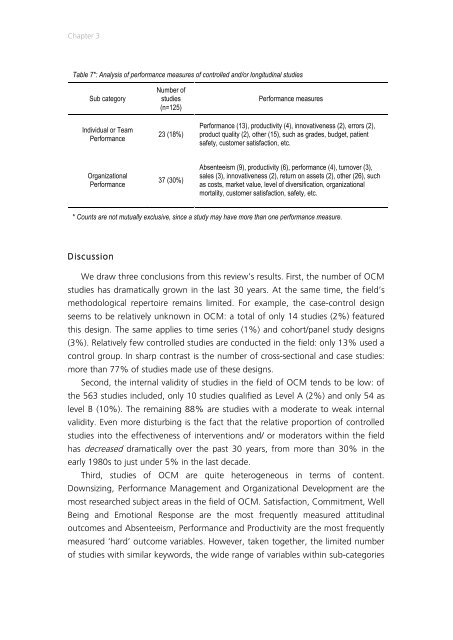In Search of Evidence
jqluvth
jqluvth
Create successful ePaper yourself
Turn your PDF publications into a flip-book with our unique Google optimized e-Paper software.
Chapter 3<br />
Table 7*: Analysis <strong>of</strong> performance measures <strong>of</strong> controlled and/or longitudinal studies<br />
Sub category<br />
<strong>In</strong>dividual or Team<br />
Performance<br />
Number <strong>of</strong><br />
studies<br />
(n=125)<br />
23 (18%)<br />
Performance measures<br />
Performance (13), productivity (4), innovativeness (2), errors (2),<br />
product quality (2), other (15), such as grades, budget, patient<br />
safety, customer satisfaction, etc.<br />
Organizational<br />
Performance<br />
37 (30%)<br />
Absenteeism (9), productivity (6), performance (4), turnover (3),<br />
sales (3), innovativeness (2), return on assets (2), other (26), such<br />
as costs, market value, level <strong>of</strong> diversification, organizational<br />
mortality, customer satisfaction, safety, etc.<br />
* Counts are not mutually exclusive, since a study may have more than one performance measure.<br />
Discussion<br />
We draw three conclusions from this review’s results. First, the number <strong>of</strong> OCM<br />
studies has dramatically grown in the last 30 years. At the same time, the field’s<br />
methodological repertoire remains limited. For example, the case-control design<br />
seems to be relatively unknown in OCM: a total <strong>of</strong> only 14 studies (2%) featured<br />
this design. The same applies to time series (1%) and cohort/panel study designs<br />
(3%). Relatively few controlled studies are conducted in the field: only 13% used a<br />
control group. <strong>In</strong> sharp contrast is the number <strong>of</strong> cross-sectional and case studies:<br />
more than 77% <strong>of</strong> studies made use <strong>of</strong> these designs.<br />
Second, the internal validity <strong>of</strong> studies in the field <strong>of</strong> OCM tends to be low: <strong>of</strong><br />
the 563 studies included, only 10 studies qualified as Level A (2%) and only 54 as<br />
level B (10%). The remaining 88% are studies with a moderate to weak internal<br />
validity. Even more disturbing is the fact that the relative proportion <strong>of</strong> controlled<br />
studies into the effectiveness <strong>of</strong> interventions and/ or moderators within the field<br />
has decreased dramatically over the past 30 years, from more than 30% in the<br />
early 1980s to just under 5% in the last decade.<br />
Third, studies <strong>of</strong> OCM are quite heterogeneous in terms <strong>of</strong> content.<br />
Downsizing, Performance Management and Organizational Development are the<br />
most researched subject areas in the field <strong>of</strong> OCM. Satisfaction, Commitment, Well<br />
Being and Emotional Response are the most frequently measured attitudinal<br />
outcomes and Absenteeism, Performance and Productivity are the most frequently<br />
measured ‘hard’ outcome variables. However, taken together, the limited number<br />
<strong>of</strong> studies with similar keywords, the wide range <strong>of</strong> variables within sub-categories


